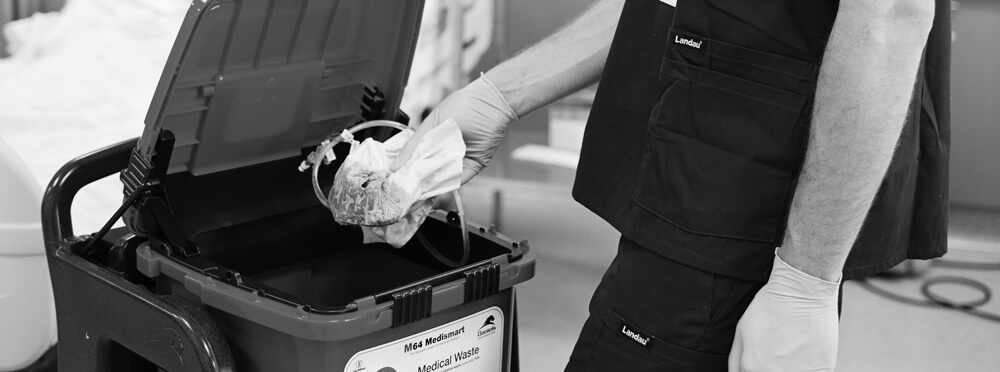Navigating Medical Waste Regulations and Industry Oversight

When it comes to medical waste disposal, compliance with federal and state guidelines is essential. But first, it’s vital to know who regulates the medical waste disposal industry.
TOPICS WE WILL COVER:
- Getting Started
- Medical Waste Regulation: Disposal, Storage and Transport
- Who Regulates the Medical Waste Disposal Industry?
- Regulations For the Collection and Disposal of Medical Waste
- Acceptable Treatments for Regulated Medical Waste
- Why Compliance Matters for Healthcare Facilities
- Daniels Health: Your Partner in Compliance and Safety for Medical Waste Management
Getting Started
Compliance can get a bit confusing for healthcare facilities—large and small—because regulations differ between different types of medical waste and their required disposal and treatment methods. Let us help…
Depending on service volume and size of the facility, healthcare organizations may generate the following waste streams:
- Microbiological waste
- Sharps waste
- Biohazard waste
- Infectious waste
- Pathological waste
- Pharmaceutical waste
- Chemotherapy waste (or other chemical waste including laboratory reagents, disinfectants, film developers)
Waste segregation is the first step in maintaining compliance with hazardous waste disposal.
State and federal guidelines for medical waste management clearly define how each category of waste should be collected and disposed of; for example there is a big difference in how sharps can be disposed of and how chemotherapy waste should be disposed of. Daniels Health understands the importance of clarity, especially when it comes to federal and state guidelines for the storage, transport, and the disposal of non-hazardous and hazardous medical waste.

Medical Waste Regulation: Disposal, Storage and Transport
According to the Environmental Protection Agency, regulations for the storage, transport, and disposal of medical waste depend on the type of medical waste under consideration. Acceptable methods for disposing of a syringe with a needle are different to those concerning the disposal of an animal carcass or human tissues.
This is why specificity is key. For example, when it comes to disposal of sharps, they are to be placed into a container that is:
- Shatterproof, durable (due to heavy handling), leak-proof, and puncture resistant
- Marked with a universal biohazard label
- Designed so that during handling, contents won’t fall out
- Equipped with a safe yet accessible opening that enables users to easily determine when the container is full
Pharmaceutical Waste Disposal Guidelines
Guidelines for pharmaceutical waste disposal are more complicated, specifically dependent upon the definition of various hazardous waste categories. The EPA classifies pharmaceutical waste by four categories:
- Regulated hazardous pharmaceutical waste
- Non-regulated hazardous pharmaceutical waste
- Non-regulated “non-hazardous” pharmaceutical waste
- Minimization of pharmaceutical waste
* Other considerations must be factored into these categories such as dosages and form of the pharmaceutical waste (tablet, capsule, injectable).
Who Regulates the Medical Waste Disposal Industry?
Healthcare facilities are responsible for checking with state regulators as well as federal agencies regarding interpretation of medical waste disposal regulations. To remain compliant, should regularly refer to the rulings and summaries for management standards of medical waste. State regulations may be more stringent than federal guidelines and vary from state to state, and those guidelines and regulations are routinely updated.
But who regulates the medical waste disposal industry? There are actually several agencies involved, including:

- The Environmental Protection Agency (EPA)
- Department of Transportation (DOT)
- Occupational Safety and Health Administration (OSHA)
- State environmental protection agencies
- State pharmacy boards
- Local publicly owned treatment works (POTW)
The first step is to define and segregate medical waste for disposal. Compliant collection and transport of medical waste is also specifically mandated.
Regulations for the Collection and Disposal of Medical Waste
Proper management of medical waste is crucial to ensure compliance with both federal and state regulations. A clinic must comply with regulations regarding the disposal of medical waste by following strict guidelines to segregate, transport and dispose of hazardous and non-hazardous waste responsibly. Each type of medical waste is defined by regulatory bodies, and compliance is essential to protect public health and the environment.
Segregation and Transport Requirements
Waste segregation is the first step in regulatory compliance. All medical waste must be properly categorized before disposal and transportation to prevent cross-contamination and ensure the correct treatment process is applied.
Healthcare facilities may also transport waste directly to an authorized hospital or waste depot, provided they meet EPA and DOT regulations for transporting medical waste. Failure to comply with these regulations can result in fines and legal consequences.
Regulatory Framework for Medical Waste Disposal
The disposal of medical waste (concerning both hazardous and non-hazardous waste) in the US is primarily governed by:
- Resource Conservation and Recovery Act (RCRA): This act oversees the management of hazardous and non-hazardous waste.
- Hazardous and Solid Waste Amendments (HSWA): Extending the RCRA, these amendments regulate the disposal of biohazard waste and other hazardous materials.
The key objective of these regulations is to provide protection for human health and wellness and the environment, from the generation, transportation, treatment, storage, and/or disposal of hazardous wastes. These objectives specify that wastes be properly treated before disposal, reducing harm to groundwater, leeching of hazardous waste and particulates into the environment, and reducing toxicity by previously removing or destroying harmful particles and/or constituents of medical waste.
When it comes to treatment standards, special regulatory requirements apply to certain types of waste with specific characteristics, such as:
- Corrosive waste
- Reactive waste
- Toxic waste
- Ignitable waste
The bottom line? Any hazardous waste that will ultimately end up in some form of land disposal or disbursement is required to meet all applicable treatment standards prior to such disposal processes. Standards applicable to hazardous waste can be found under Title 40 of the Code of Federal Regulations (CFR) §268.40.
Acceptable Treatments for Regulated Medical Waste
As trusted partners in waste compliance, we are dedicated to ensuring that all medical waste treatment is conducted responsibly, following all applicable legislation, regulations, codes of practice, standards and licensing requirements. Where both local and federal regulations allow, Daniels prioritizes the most environmentally sustainable disposal solutions. Acceptable treatments for regulated medical waste are carefully selected to align with compliance and sustainability goals.
Thermal Autoclave Treatment
Daniels Health uses thermal autoclave treatment for regulated medical waste disposal (RMW). This includes sharps, regulated medical waste and pathological waste (excluding arms, legs and torsos). Autoclave is the most environmentally responsible process for the treatment of RMW and other infectious wastes and aligns with our mission of sustainability throughout our operations.
How Does Autoclave Treatment Work?

Utilizing pressure chambers that sterilize supplies and equipment in steam “baths” of approximately 285°, the Autoclave denatures the waste by way of high-pressure steam sterilization. Autoclave chambers differ in size, with some of the largest ranging from 30 feet long, to 6 feet wide, and 6 feet tall.
Waste remains in the autoclave for at least 20 minutes, and the pressure chamber typically runs through three cycles for a total time of 60 minutes. By the end of the cycle, the waste contents have been reduced (melted) and commingled with all other waste and represent a volume less than 50% of the original volume. Processed waste is then either compacted or shredded.
Alternative Non-Incineration Methods
Other “non-incinerated” medical waste disposal options are available, including:
- Chemical – most common in the treatment and disposal of liquid wastes and chemical wastes
- Microwave (irradiative) – microwave or irradiation methods are effective for infectious wastes and sharps wastes, but are not intended for use with pathological waste
Incineration and Future Directions
Technological advancements in the US regarding medical waste disposal focus on reducing hazards to humans and the environment. The most common method for the treatment and destruction of non-RMW medical waste is medical waste incineration, which Daniels Health utilizes most commonly for chemotherapy, pharmaceuticals and other forms of hazardous waste.
Why is Incineration So Popular?
Incineration continues to be the most cost-effective method of medical waste disposal, with incinerators burning at temperatures ranging anywhere between 1000°F and 2000°F. In the US, research and development continue to seek ways to reduce emissions produced via incineration.
Regulatory Oversight and Environmental Considerations
The Clean Air Act requires the EPA to review standards for medical waste incinerators every five years, with requirements for lowering emissions from air pollutants and improving segregation and medical waste management methods.
The number of medical waste incinerators in the US has declined by approximately 25% while promoting less expensive and more environmentally friendly alternatives such as autoclaving. Nevertheless, a fifteen-year plan for upgrades for hospital, medical, and infectious waste incinerators was to be met by February 2018 regarding existing facility compliance under CAA §129. The ultimate goal of the EPA is to end all incineration methods in the US, promoting instead autoclaving/landfilling alternatives that would reduce the amount of toxic air emissions annually
Why Compliance Matters for Healthcare Facilities
A clinic must comply with regulations regarding the disposal of medical waste to:
- Ensure Patient and Staff Safety: Proper waste management minimizes exposure to hazardous materials.
- Avoid Legal and Financial Consequences: Regulatory violations can result in hefty fines and reputational damage.
- Protect the Environment: Following proper disposal guidelines prevents contamination of water sources and ecosystems.
- Streamline Waste Management Operations: Compliance promotes efficient waste handling and cost-effective solutions.
By following biohazard waste disposal guidelines, facilities can maintain a safe and compliant environment while reducing operational risks.
Daniels Health: Your Partner in Compliance and Safety for Medical Waste Management
Daniels Health stands at the forefront of medical waste management, offering unparalleled expertise in ensuring compliance and safety across healthcare facilities.
With a vigilant eye on the ever-evolving landscape of federal and state regulations, Daniels Health proactively adapts its products and services to meet the highest standards of compliance. This commitment is reflected in our comprehensive solutions tailored to manage a broad spectrum of regulated medical waste. By prioritizing customer safety and strict adherence to regulatory frameworks, Daniels Health solidifies its role as a trusted partner in the healthcare industry, dedicated to safeguarding both healthcare workers and the community at large.
The Daniels Difference
With 38 years of experience in healthcare, we understand it all starts on the human level within the four walls of a healthcare facility. From minimizing waste to effective segregation that facilitates lower costs, enhanced compliance, and sustainable processing and treatment, Daniels Health focuses on technologies that minimize exposure to high-risk waste streams and reduce the volume of solid waste going to landfills. What’s more, we have a strong understanding of who regulates the medical waste disposal industry and how to comply.
Learn more about the disposal of medical waste, regulations, and our treatment solutions through our Operations menu here.
Let's Talk!
Your time is valuable, and we don’t want to play hard to get. You can either phone us directly on the details listed on our contact page, or feel free to fill out this short form and one of our team members will get back to you as quickly as possible.
